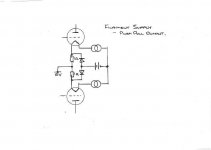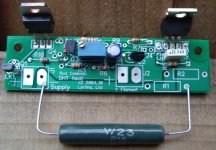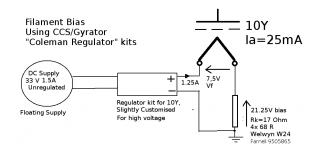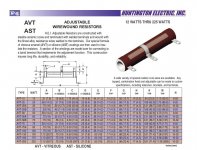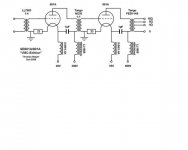Hi Rod, here is another question. I am collecting parts for a OTL using the 6C33C tube...2 per channel. It is an OTL design but as I understand it, an OTL is a PP. They call the 6C33C a triode but it has more than just the three elements. It is also 12v at 3a.
SO, my question is: do you think this design would benefit from your boards? If so, which board, the SET or PP? Here are links to the tube data and the scheem for the OTL. CHeers.
SO, my question is: do you think this design would benefit from your boards? If so, which board, the SET or PP? Here are links to the tube data and the scheem for the OTL. CHeers.
Attachments
Hi Dennis,
Indirectly Heated power tubes don't usually require special precautions with the heater - ac should be fine with the 6C33C.
The amplifier looks quite high gain though, and it's possible that the sound quality, and hum level would be improved by heating the ECC83s with current sources. The heaters for ECC83 should be able to be series connected (using the same maker for all tubes).
The PP heat board can heat the ECC83s this way - it holds 2x CCS per PCB. You can connect two heaters in series (and probably 3) and connect each series string to one CCS. That way, one PCB can give CCS heating to four ECC83 (ie eight triode sections). So, you can heat preamp/line amp heaters with the same PCB and power supply, and get quietest results.
As a deluxe feature, the PCB includes positions for the resistors and capacitor needed for raising the heaters above ground - typically 30 to 60V, by dividing down from B+.
This should always be applied to indirectly heated voltage amplifier heaters - to prevent noise conduction between heater and cathode.
Indirectly Heated power tubes don't usually require special precautions with the heater - ac should be fine with the 6C33C.
The amplifier looks quite high gain though, and it's possible that the sound quality, and hum level would be improved by heating the ECC83s with current sources. The heaters for ECC83 should be able to be series connected (using the same maker for all tubes).
The PP heat board can heat the ECC83s this way - it holds 2x CCS per PCB. You can connect two heaters in series (and probably 3) and connect each series string to one CCS. That way, one PCB can give CCS heating to four ECC83 (ie eight triode sections). So, you can heat preamp/line amp heaters with the same PCB and power supply, and get quietest results.
As a deluxe feature, the PCB includes positions for the resistors and capacitor needed for raising the heaters above ground - typically 30 to 60V, by dividing down from B+.
This should always be applied to indirectly heated voltage amplifier heaters - to prevent noise conduction between heater and cathode.
Thanks Rod. I might add your boards to the list of parts to collect. I have to finish the GM70 first though. I will be finalizing the chassis for the GM this month and then I can start wiring. I'll PM you for details of the boards for the GM70.
Ian, That's what I was thinking.
The difference in voltage between the 1-ohm resistors is forced to appear across the filament CCSs - which is fine, they're designed to cope with that.
The 1-ohm resistors should be able to sense anode current without interference from its opposite half, allowing the autobias circuit to operate.
The difference in voltage between the 1-ohm resistors is forced to appear across the filament CCSs - which is fine, they're designed to cope with that.
The 1-ohm resistors should be able to sense anode current without interference from its opposite half, allowing the autobias circuit to operate.
Guess I need $
I would like 4 boards please...
Let me know as to cost and paypal address
I will use my wife's account/// Christine Cassidy
Phil Townsend
I would like 4 boards please...
Let me know as to cost and paypal address
I will use my wife's account/// Christine Cassidy
Phil Townsend
I remember Rod commenting that they are a bit of an equalizer in helping the lower cost DHTs compete with premium models. Anyone care running these care to comment on that ?
Trying to set a budget for this headamp SET #26-45-OPT.
Trying to set a budget for this headamp SET #26-45-OPT.
Hi
I’ve been meaning to write this for a while, but have been too busy listening to music…. 🙂
About a month ago I fitted Rod’s regs into my dual mono, multi valve rectified choke input regulated, fixed biased, interstage transformer driven WE300B SE amp- to sensational effect! The improvement this provided still staggers me. Anyone who is wondering whether to try this or not should not hesitate!
Everything improves. Bass gains power, apparent extension and control. Fine detail increases- you can hear right into the harmonic decay of e.g. violin and piano notes, everything sounds vivid and real. Treble is just so natural and extended, and imaging improves too. Awesome!
I started years back with a voltage regulated supply, but rapidly changed to unregulated dc from carefully selected caps and rectifiers. I always meant to try a CCS, but never did (even the Ronan supply which was popular a few years back) until earlier this year, when I fitted filaments supplies from DIY Hifi Supply- a CCS with dc voltage regulation, based on a 1084 chip reg. A big step in the right direction, but nothing IMO compared with Rod’s design.
I mounted the MOSFETS on a 40 x 10 mm copper block, bolted to the metal chassis. They run only hand hot- about 40°?
Thanks Rod!
Paul
I’ve been meaning to write this for a while, but have been too busy listening to music…. 🙂
About a month ago I fitted Rod’s regs into my dual mono, multi valve rectified choke input regulated, fixed biased, interstage transformer driven WE300B SE amp- to sensational effect! The improvement this provided still staggers me. Anyone who is wondering whether to try this or not should not hesitate!
Everything improves. Bass gains power, apparent extension and control. Fine detail increases- you can hear right into the harmonic decay of e.g. violin and piano notes, everything sounds vivid and real. Treble is just so natural and extended, and imaging improves too. Awesome!
I started years back with a voltage regulated supply, but rapidly changed to unregulated dc from carefully selected caps and rectifiers. I always meant to try a CCS, but never did (even the Ronan supply which was popular a few years back) until earlier this year, when I fitted filaments supplies from DIY Hifi Supply- a CCS with dc voltage regulation, based on a 1084 chip reg. A big step in the right direction, but nothing IMO compared with Rod’s design.
I mounted the MOSFETS on a 40 x 10 mm copper block, bolted to the metal chassis. They run only hand hot- about 40°?
Thanks Rod!
Paul
I remember Rod commenting that they are a bit of an equalizer in helping the lower cost DHTs compete with premium models. Anyone care running these care to comment on that ?
Trying to set a budget for this headamp SET #26-45-OPT.
Dave, I've put my money on the bargain DHTs! I am about 8 hours into a new set of EH 300B - and they sound very fine already.
The construction quality appears to be a lot better than the old Sovtek black-base model they replaced. Height is reduced, (and consequently, I believe), microphony is lowered as well. Alignment of internal features looks much improved. The EH is still available at a low price, and even with the regulator kits, lower than most alternatives.
The regulators improved the Sovtek beyond recognition.
The new EH filament behaves just like the old Sovtek - very quick heating compared to other makers' 300Bs - I guess it's relatively thin. The old model sounded cloudy & muddy on AC heating, so perhaps there is some thermal or electromechanical effect reacting with the ac. This is in addition to the modulation of the anode-current - by fundamental and overtones of the ac heating frequency - which is a proven distortion mechanism in ac-heated filaments.
BTW, the GM70 filament behaves much the same with very quick warmup - less than 10seconds even with CCS heating - and mechanical resonances are also similar. I'm expecting good upgrade performance with this DHT.
DHT warm up in fractions of seconds, while IDHT have S-shaped curve, with few seconds of "no effect" time. However, time needed for 90% of plate current is longer than fraction of seconds, though, that's why it is specified in seconds.
HI Rod,
When do you estimate the boards will be available? I'm ready for some.
Thanks,
John
Hi John,
The new PCBs are due on November 22 [next week], so I hope to start shipping kits shortly after that.
This is a new version-2 PCB with support for the big Transmitting DHTs in SE amplifiers.
There is a PP version all laid out, but needs a little more interest to justify sending out for fabrication yet.
The regulators are available as 2 PCB + component kit - ALL the PCB parts. But, you must add your own Heatsink, & dc supply - transformer, rectifier, capacitors. Full details of the external parts you need are given in the PDF Application notes - which have lots of info on Building and Use of the kits - please send some PM to have a copy.
jrd
Hi Rod:
Please put me down for two regulator PCB's plus component kits for
the 26 tube.
TIA,
John
Hi Rod:
Please put me down for two regulator PCB's plus component kits for
the 26 tube.
TIA,
John
Just a quick note to say that I've finished Rod's supply for my 300B SET amp, and I'm really happy with the sound improvement.
The amp used to have a simple single CRC filtered supply for both tubes, so going to 2 seperate supplies is probably helping as well.
Also the extra heat generated by the supply is welcome in this cold winter. (It might be getting problematic in the summer though, buying an airco is being considered 🙂
The amp used to have a simple single CRC filtered supply for both tubes, so going to 2 seperate supplies is probably helping as well.
Also the extra heat generated by the supply is welcome in this cold winter. (It might be getting problematic in the summer though, buying an airco is being considered 🙂
Thanks for the feedback Mark! good to hear that the regulators work well for you.
The Transmitting-Tube versions are all qualified and ready now, including 845 3C24, GM70. I believe that GM70 builders will be especially pleased with these, as these filaments really do not like ac, nor dc with electrolytics across the filament terminals.
The newest version is for the 75TL. I hope Gianluca won't mind if I show a picture of his regulators... these are 5V 6.25A. The filament is a dead short when cold, so these regulators are designed to take a 1 minute short-circuit [with a minimal heatsink], or an indefinite short-circuit if you are mounted on a good-sized chunk of metal.
.
The Transmitting-Tube versions are all qualified and ready now, including 845 3C24, GM70. I believe that GM70 builders will be especially pleased with these, as these filaments really do not like ac, nor dc with electrolytics across the filament terminals.
The newest version is for the 75TL. I hope Gianluca won't mind if I show a picture of his regulators... these are 5V 6.25A. The filament is a dead short when cold, so these regulators are designed to take a 1 minute short-circuit [with a minimal heatsink], or an indefinite short-circuit if you are mounted on a good-sized chunk of metal.
.
Attachments
HI Rod I'm waiting info for filament bias 10y 25ma
thanks
Hi Manu,
I think I would do it like this:
The cathode resistor burns nearly 27W in this configuration! I would use 4x 68R 14W as a minimum rated power handling for this setup. The Welwyn W24 vitreous enamelled wirewound is a good low cost part for this position - good quality too.
THe raw dc supply must be floating from system ground - see drawing.
THe 26 DHT would burn much less power in a filament bias connexion.
But you can use my regulator boards in this way with no problem. They will sound much better than any 3-terminal regulator chip in the same position - and will not suffer the problems that ICs have with start-up current-limit, and instability. The boards will be tweaked with higher voltage capacitor, and a resistor change.
Attachments
Manu, remember that the filament CCS is adjustable. You can adjust the bias using the filament current. Just be sure that the filament voltage is 7.2 to 7.6V.
Or you can use those Huntingdon rheostats (50W +).
At the input, you can use transformer (like your drawing) or -
- capacitor coupling;
- or use nothing! use dc coupling if your source has no offset!
Or you can use those Huntingdon rheostats (50W +).
At the input, you can use transformer (like your drawing) or -
- capacitor coupling;
- or use nothing! use dc coupling if your source has no offset!
- Home
- Amplifiers
- Tubes / Valves
- New DHT heater
